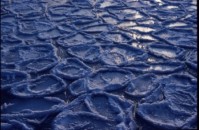The sea ice
 The photograph shows a sheet of sea ice that has been thrust onto another sheet by dynamic processes. This sheet consisted either of thick one-year-old ice or thin perennial ice. The uppermost layer, just above the hand of the scientist, is most likely snow which has fallen on the ice.
Illustration: Sebastian Gerland, NPI
The photograph shows a sheet of sea ice that has been thrust onto another sheet by dynamic processes. This sheet consisted either of thick one-year-old ice or thin perennial ice. The uppermost layer, just above the hand of the scientist, is most likely snow which has fallen on the ice.
Illustration: Sebastian Gerland, NPI
 A completely different type of sea ice is pancake ice, which is common when new ice forms. It mostly consists of almost circular plates between 30 centimetres and 3 metres in size, and up to 10 centimetres thick. The raised lip forms because the plates are continually colliding with each other.
Illustration: Hallvard Strøm, NPI
The sea ice is the quay for Arctic Ltd; it is the direct extension of the land and the link between the sea and the land. For some animals, it is a place where they can rest and find protection, but for others it offers better opportunities for hunting.
A completely different type of sea ice is pancake ice, which is common when new ice forms. It mostly consists of almost circular plates between 30 centimetres and 3 metres in size, and up to 10 centimetres thick. The raised lip forms because the plates are continually colliding with each other.
Illustration: Hallvard Strøm, NPI
The sea ice is the quay for Arctic Ltd; it is the direct extension of the land and the link between the sea and the land. For some animals, it is a place where they can rest and find protection, but for others it offers better opportunities for hunting.
The majority of the Arctic consists of sea, and as temperatures are low, large amounts of sea ice form every winter. Because it does not completely melt each summer, the ice lying over the North Pole region is formed over several years. However, the summer sea ice in the Arctic has decreased in extent over the past 30 years, and in 2007 and 2008 it covered an area of only about 4 mill. km2 instead of the 7 mill. km2 it covered previously. In winter, the area of sea ice is trebled, but because more new ice must continually be formed, there is less perennial ice in the Arctic than there used to be.
The formation and melting of sea ice depend upon many factors. The water and air temperatures play the most obvious role, but the frequency and strength of the wind are also important. New ice is not so easily formed if the wind continually breaks up and carries away the sheets. The salt content of the sea also plays an important role. Salt water has a lower freezing point than fresh water and the saltier the water the lower the temperature has to be before it freezes. The salt content in the sea is related to the precipitation in the area, melting of sea ice, and also melting and runoff in summer in sur-rounding land areas.
Did you know...
 90 % of the ice that leaves the Arctic Ocean exits through the Fram Strait between Svalbard and Greenland. Thin, one-year ice is less resistant than the thicker, multi-year ice and is more easily swept along by the wind.
90 % of the ice that leaves the Arctic Ocean exits through the Fram Strait between Svalbard and Greenland. Thin, one-year ice is less resistant than the thicker, multi-year ice and is more easily swept along by the wind.